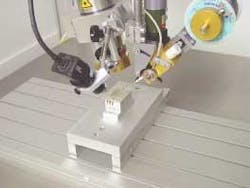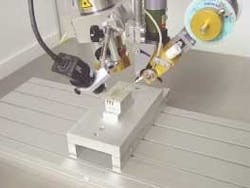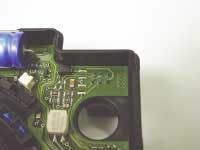Selecting laser selective soldering
For years, engineers had specified manual, hot iron soldering for electrical components and, during the last decade, this selective soldering process has been automated for the production floor. A typical automation process may incorporate a heating element on a robotic arm that can be moved around the joint area and a solder wire that is automatically fed into the joint area. Today a laser system represents one of several technologies available to act as the heating element (see Figure 1).
Iron soldering—Because almost every engineer has used a soldering iron, the automated soldering iron process is perhaps the easiest to sell and implement on a widespread basis. Soldering irons are inexpensive, robust, and provide a wide degree of flexibility in the applications served. All this makes the soldering iron technique the most prevalent method of automated selective soldering.
But there are drawbacks to the soldering iron, the biggest being the full-contact nature of the process, which can introduce impurities into the soldering area, making soldering irons unsuitable for very clean processes. The tip of the soldering iron must be cleaned regularly to remove flux and solder oxide buildup, and eventually the tip must be replaced. The buildup of flux and solder oxide result in gradual changes to the process over time, so very tight process control is difficult to implement. Also, using a soldering iron requires that some force be exerted on the substrate, which can be detrimental to fragile substrates such as ceramic. Finally, the soldering iron's heat spreads beyond the joint area, so that heat-sensitive components in close proximity may be damaged.
Micro-flame soldering—Micro-flame soldering, a localized, non-contact method, utilizes a gas flame, typically an oxygen and hydrogen mixture, to heat the solder. The high temperature of the flame can quickly heat substrates such as ceramic, cast molded circuits, insulated magnet wires, and heavy gauge wires. The flame's temperature is high enough to melt brazing alloys with melt points above 450° C, as opposed to just lead-based solders that melt at around 180° C.
Disadvantages of micro-flame soldering include the potential to overheat nearby components; the safety aspects of working with a live flame, and the arc-discharge mechanism that triggers the flame can damage sensitive electronic components.
Induction soldering—Induction soldering involves placing a copper conductor around the joint to be soldered, and applying a high-frequency voltage to the conductor. This creates an alternating magnetic field, creating Foucault current flows through the materials, which in turn heats the joint and solder.
The advantages of induction soldering are its non-contact and clean nature; very quick heating; ability to melt high-temperature solders; and high repeatability. Also, an induction solder joint can be formed over a relatively long area all at once. Typical applications include high-temperature soldering of coaxial connectors and coil wires, and silver brazing.
The disadvantages include its high initial cost, the complexity of determining the appropriate settings that are based on material conductivity, and accommodating the physical space requirements of the copper conductor.
Laser soldering—According to studies (Optech Consulting), the market for laser soldering systems in 2003 was about $15 million and is growing at 15 to 20 percent per year. While still not a huge market, selective laser soldering recently has gained popularity as the need to solder smaller components continues to emerge. Specifically, laser soldering represents the best method to solder surface mount components onto PC boards, and is well suited for ball grid array (BGA) soldering (see Figure 2). The 0.5- to 1-mm spot sizes typically achieved with diode laser soldering systems allow for very localized heating, while the delivered energy can be precisely controlled. Laser soldering provides a clean, non-contact process with virtually no collateral damage concerns. This process allows for soldering smaller components than the alternative technologies allow.
Both diode systems and TEM00 lasers, such as fiber lasers and diode-pumped solid-state (DPSS) Nd:YAG lasers, can be used for laser soldering. However, diode systems represent an attractive economical approach because their cost per watt is about one-third that of a TEM00 laser. Consequently, the vast majority of laser soldering installations incorporates diode systems. Systems typically range in output power from 10 to more than 100 watts, with most applications requiring around 50 W. The power requirement primarily is determined by the size of the solder ball and the melting point of the solder.
The drawbacks of laser soldering include the high relative price of a laser, the additional cost associated with meeting laser safety requirements, and a limited ability to solder large areas.
Advances in laser soldering
A primary requirement for a laser soldering system is that it can be switched on and off at a frequency of around one hertz, as this approximates the time required to laser solder a joint. This continuous power cycling of the diode lasers historically caused reliability problems because the diodes used in laser soldering systems generally have been 20- and 30-W diode bars. Due to packaging limitations, bar diodes quickly fatigue when power cycled, and have demonstrated relatively short life expectancies as a result.
JDS Uniphase utilizes many single-emitter diodes, combined together, rather than one or a few bar diodes. These single-emitter diodes do not exhibit the fatigue issues associated with bar diodes, and as a result have much longer expected lifetimes in soldering systems than bar-based systems. Cycled life test data for a JDS Uniphase Industrial Diode Laser (IDL) system shows that power decreases only one to three percent after 5300 hours of operation. In addition, if one single-emitter diode fails, the others will continue to operate. In comparison, if one emitter fails on a diode bar, then the entire bar fails.
Another development is the recent emergence of TEM00 lasers, such as fiber and DPSS lasers, for laser soldering. Although a diode system's cost per watt is less, a TEM00 laser can accommodate spot size requirements that diode systems cannot address. While diode systems generally can focus to a spot diameter of about 0.5 mm, certain soldering applications in the electronics and storage industries require spot sizes of 0.1 mm. This spot size can be easily addressed with a TEM00 laser. The other advantage of using a TEM00 laser is the longer depth of field inherent in a single mode beam. This allows for longer working distances than diode systems, which eases access problems often associated with diode systems and the alternative technologies. In these circumstances, the only viable alternative is a TEM00 laser, and the ideal candidate for such applications is a continuous-wave fiber laser because of its good mode quality and ease of integration.
Conclusion
While various technologies can be used for selective soldering, the specific application will dictate which technology is most suitable. It will be some time before laser soldering completely displaces hot iron soldering to become the dominant technology but ongoing miniaturization efforts in electronics and packaging will fuel a steady growth in the laser selective soldering business. For this growth to continue, advances in diode system reliability such as those provided by ganged single-emitter diodes need to occur. Also, as miniaturization advances, TEM00 lasers such as fiber lasers will become more prevalent in selective soldering applications.
Andrew Leuzinger, a product line manager for JDS Uniphase (Santa Rosa, CA), can be contacted by e-mail at [email protected].


